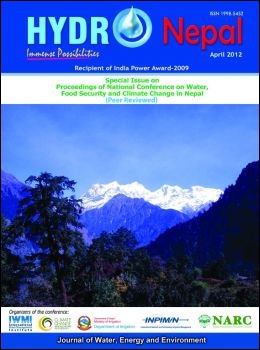The Impact of Climate Change on Water Availability in Eastern Nepal: A Presentation of the Project Methodology taking into Account the Various Origins of Water
DOI:
https://doi.org/10.3126/hn.v11i1.7197Keywords:
Water resources, water uses, climate changes, precipitations (snow and rain), Eastern NepalAbstract
The paper reflects the main methodological aspects of the PAPRIKA Project based on the following objectives: (i) to contribute to a more accurate assessment of glacier retreat, snow cover and climate change in Koshi Basin, Nepal; (ii) to have a better understanding of the contribution of glacier and snow melting to water availability; (iii) to correlate the results with local people's perceptions of climate change and their socio-economic impact. For this, the paper:
- highlights the fact that the water used by the population comes from different origins (glacier melting, snow melting, frost, rain) the combination of which varies between the four main landscape units: high, middle and low mountains, and finally the Terai plain;
- describes the methodology adopted to observe and analyse current as well as future environmental changes in the atmosphere, cryosphere and hydrosphere;
- shows that, for each origin, different reasons may explain the changes in water availability, and thus the impact on agriculture and the different water usages.
DOI: http://dx.doi.org/10.3126/hn.v11i1.7197
Hydro Nepal Special Issue: Conference Proceedings 2012 pp.12-17
Downloads
Downloads
Published
How to Cite
Issue
Section
License
The copyright of the articles and papers published is held by HYDRO Nepal Journal.
The views and interpretation in this journal are those of author(s), and HYDRO Nepal does not bear any responsibility for the views expressed by authors in the journal.




